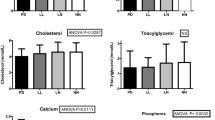Abstract
Fecal fat excretion, fecal mass, fecal fat concentration, and the coefficient of fat absorption were evaluated in 31 normal Japanese subjects with a mean fat consumption of 61.8 g and compared with the values in 43 Japanese patients with chronic pancreatitis (CP) with a fat consumption of 40.2g. Fecal fatty acids were analyzed by the gas Chromatographic method. Fecal fat excretion by normal individuals was 1.7±1.0 (Mean±SD) g/day (range, 0.4–4.9 g/day). Steatorrhea was therefore defined as fecal fat excretion that exceeded 5.0 g/day. The patients with CP were divided into three groups: non-steatorrhea (fecal fat ≪5.0g/day), chemical steatorrhea (fecal fat ≥5 g/day and no appearance of fatty stool), and manifest steatorrhea (evaluated from the appearance of fatty stool). In addition, we investigated the correlation between fecal fat excretion and pancreatic exocrine function, obtained by the pancreozymin-secretin (or secretin) test in 24 controls and 30 CP patients. Fecal fat excretion by CP patients was 9.1±8.8 g/day, which was significantly higher (P<0.01) than that of controls. There were 28 (65%) CP patients with steatorrhea. Of these, 15 (35%) showed chemical steatorrhea and 13 (30%) manifest steatorrhea. In CP patients, the fecal mass (250.5±133.6 g vs control, 125.6±52.5 g), fecal fat concentration (3.40±2.16g% vs control, 1.48±0.89g%), and coefficient of fat absorption (77.3±20.2% vs control, 97.2±1.7%) all showed significant differences from the controls. Of these three indices—fecal mass, fecal fat concentration, and coefficient of fat absorption—fecal fat concentration was the most useful for identifying pancreatic steatorrhea. In addition, there were significantly different correlations between fecal fat excretion and pancreatic exocrine function in patients' group and control group. Fecal fat excretion was clearly correlated with amylase output. These findings led to the conclusion that steatorrhea indeed exists among Japanese CP patients who consume small amounts of dietary fat; and that fecal fat excretion is closely correlated with pancreatic exocrine dysfunction.
Similar content being viewed by others
References
Nakamura T, Kikuchi H, Takebe K, et al. Correlation between bile acid malabsorption and pancreatic exocrine dysfunction in patients with chronic pancreatitis. Pancreas 1994;9:580–584.
Pimparkar BD, Tulsky EG, Kaiser MH, et al. Correlation of radioactive and chemical fecal fat determinations in various malabsorption syndromes. Am J Med 1961;30:927–939.
Graham DY. Enzyme replacement therapy of exocrine pancreatic insufficiency in man. N Engl J Med 1977:296:1314–1317.
DiMagno EP, Malagedala JR, Go VLW, et al. Fate of orally ingested enzymes in pancreatic insufficiency. N Engl J Med 1977;296:1318–1322.
Lembcke B, Grimm K, Lankisch PG. Raised fecal fat concentration is not a valid indicator of pancreatic steatorrhea. Am J Gastroentenol 1987;82:526–531.
Honma T, Kimura T, Koizumi M, Harada H, Nakano S, Wakasugi H, Komi N. Incidence of chronic pancreatitis. (Intractable Diseases of the Pancreas), The Japanese Ministry of Health and Welfare 1992;27–30 (in Japanese).
Nakamura T, Kikuchi H, Takebe K, et al. Fecal lipid excretion levels in normal Japanese females on an unrestricted diet and a fat-restricted diet measured by simultaneous analysis of fecal lipids. J Int Med Res 1992;20:461–466.
Nakamura T, Imamura K, Kasai F, et al. Fecal excretions of hydroxy fatty acid and bile acid in diabetic diarrheal patients. J Diab Comp 1993;7:8–11.
Child P, Aloe M, Mee D. Separation and quantitation of fatty acids, sterols and bile acids in feces by gas chromatography as the butyl ester-acetate derivatives. J Chromatogr 1987;415:13–26.
Roberts IM, Poturich C, Wald A. Utility of fecal fat concentrations as screening test in pancreatic insufficiency. Dig Dis Sci 1986;31:1021–1024.
DiMagno EP, Go VLW, Summerskill WHJ. Relations between pancreatic enzyme outputs and malabsorption in severe pancreatic insufficiency. N Engl J Med 1973;288:813–815.
Goldberg DM, Wormsley KG. The interrelationship of pancreatic enzymes in human duodenal aspirate. Gut 1970;1:859.
Author information
Authors and Affiliations
Rights and permissions
About this article
Cite this article
Nakamura, T., Takebe, K., Kudoh, K. et al. Steatorrhea in Japanese patients with chronic pancreatitis. J Gastroenterol 30, 79–83 (1995). https://doi.org/10.1007/BF01211379
Received:
Accepted:
Issue Date:
DOI: https://doi.org/10.1007/BF01211379



